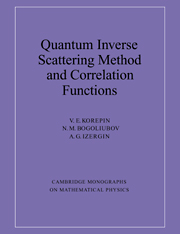Book contents
- Frontmatter
- Contents
- Preface
- Part I The Coordinate Bethe Ansatz
- Part II The Quantum Inverse Scattering Method
- Part III The Determinant Representation for Quantum Correlation Functions
- Part IV Differential Equations for Quantum Correlation Functions
- Introduction to Part IV
- XIII Correlation Functions for Impenetrable Bosons. The Determinant Representation
- XIV Differential Equations for Correlation Functions
- XV The Matrix Riemann-Hilbert Problem for Correlation Functions
- XVI Asymptotics of Temperature-dependent Correlation Functions for the Impenetrable Bose Gas
- XVII The Algebraic Bethe Ansatz and Asymptotics of Correlation Functions
- XVIII Asymptotics of Correlation Functions and the Conformal Approach
- Final Conclusion
- References
- Index
XV - The Matrix Riemann-Hilbert Problem for Correlation Functions
Published online by Cambridge University Press: 04 August 2010
- Frontmatter
- Contents
- Preface
- Part I The Coordinate Bethe Ansatz
- Part II The Quantum Inverse Scattering Method
- Part III The Determinant Representation for Quantum Correlation Functions
- Part IV Differential Equations for Quantum Correlation Functions
- Introduction to Part IV
- XIII Correlation Functions for Impenetrable Bosons. The Determinant Representation
- XIV Differential Equations for Correlation Functions
- XV The Matrix Riemann-Hilbert Problem for Correlation Functions
- XVI Asymptotics of Temperature-dependent Correlation Functions for the Impenetrable Bose Gas
- XVII The Algebraic Bethe Ansatz and Asymptotics of Correlation Functions
- XVIII Asymptotics of Correlation Functions and the Conformal Approach
- Final Conclusion
- References
- Index
Summary
Introduction
In the previous chapters correlation functions were represented as determinants of a special form of Fredholm integral operator. First, a differential equation was obtained for the time-independent zero temperature field correlation function for the impenetrable Bose gas (it depends only on one variable—distance). By means of an isomonodromic deformation technique A. Jimbo, T. Miwa, Y. Mori and M. Sato wrote down the ordinary differential equation (of Painlevè type). In the previous chapter differential equations for correlation functions in more general situations (with time, temperature and for finite coupling) were constructed. A.R. Its came up with the idea of applying the matrix Riemann problem for the description of these correlation functions (Fredholm determinants). This permits us to write down partial differential equations (completely integrable) for correlation functions and evaluate the asymptotics of correlation functions. Below we follow this line.
Integrable nonlinear partial differential equations for correlation functions of the one-dimensional nonrelativistic Bose gas with point-like repulsion between gas particles were given in section XIV. So quantum correlation functions can be expressed in terms of the solutions of classical nonlinear integrable evolution systems. These classical systems have been investigated already by means of the classical inverse scattering method. Our approach allows one, in particular, to solve the particularly interesting problem of calculating the asymptotics of correlators at large time and distance; this is done in the next section.
- Type
- Chapter
- Information
- Quantum Inverse Scattering Method and Correlation Functions , pp. 377 - 419Publisher: Cambridge University PressPrint publication year: 1993



